The Association between Charolais Cows’ Age at First Calving, Parity, Breeding Seasonality, and Calf Growing Performance
Abstract
Simple Summary
Abstract
1. Introduction
2. Materials and Methods
- Yijklm—dependent variable (gain of calves up to 210 days, gain of calves from 211 to 365 days, birth weight of calves);μ—mean value of dependent variable;Gi—fixed effect of ith gender of calf;FCj—fixed effect of jth first calving age;NCk—fixed effect of kth number of calvings;BSl—fixed effect of lth breeding season;CSj—fixed effect of mth calving season;eijklm—random error.
3. Results and Discussion
3.1. The Influence of Genderon the Birth Weight of Calves and Weight Gain
3.2. The Influence of Cows’ Age at First Calving on the Birth Weight of Calves and Weight Gain
3.3. The Influence of Calving Number on Calves’ Birth Weight and Weight Gain
3.4. The Influence of Breeding Season on Calves’ Birth Weight and Weight Gain
3.5. The Influence of Calving Season on Calves’ Birth Weight and Weight Gain
4. Conclusions
Author Contributions
Funding
Institutional Review Board Statement
Informed Consent Statement
Data Availability Statement
Conflicts of Interest
References
- Vaz, R.Z.; Cerdótes, L.; Nuñez, A.J.C.; Sartori, D.B.S.; Pacheco, R.F.; da Silva, H.R.; Bethancourt-Garcia, J.A.; Restle, J. Body Mass Index at Calving on Performance and Efficiency of Chalais Cow Herds. Trop. Anim. Health Prod. 2022, 54, 168. [Google Scholar] [CrossRef]
- Wanapat, M.; Cherdthong, A.; Phesatcha, K.; Kang, S. Dietary Sources and Their Effects on Animal Production and Environmental Sustainability. Anim. Nutr. 2015, 1, 96–103. [Google Scholar] [CrossRef]
- Contreras, V.I.P.; Bracamonte, G.M.P.; Bustamante, L.A.L.; Medina, V.R.M.; Rincón, A.M.S. Milk Composition and Its Relationship with Weaning Weight in Charolais Catte. Rev. Bras. Zootec. 2015, 44, 207–212. [Google Scholar] [CrossRef]
- Quintanilla, R.; Laloë, D.; Renand, G. Heterogeneity of Variances across Regions for Weaning Weight in Charolais Breed. In Proceedings of the 7th World Congress on Genetics Applied to Livestock Production, Montpellier, France, 19–23 August 2002. [Google Scholar]
- Renou, J.P.; Bielicki, G.; Deponge, C.; Gachon, P.; Micol, D.; Ritz, P. Characterization of Animal Products According to Geographic Origin and Feeding Diet Using Nuclear Magnetic Resonance and Isotope Ratio Mass Spectrometry. Part II Beef Meat. Food Chem. 2004, 86, 251–256. [Google Scholar] [CrossRef]
- Brzáková, M.; Čítek, J.; Svitáková, A.; Veselá, Z.; Vostrý, L. Genetic Parameters for Age at First Caing and First Calving Interval of Beef Cattle. Animals 2020, 10, 2122. [Google Scholar] [CrossRef]
- Grings, E.E.; Roberts, A.J.; Geary, T.W.; MacNeil, M.D. Milk Yield of Primiparous Beef Cows from Three Calving Systems and Varied Weaning Ages. J. Anim. Sci. 2008, 86, 768–779. [Google Scholar] [CrossRef]
- Sapkota, D.; Kelly, A.K.; Crosson, P.; White, R.R.; McGee, M. Quantification of Cow Milk Yield and Pre-Weaning Calf Growth Response in Temperate Pasture-Based Beef Suckler Systems: A Meta-Analysis. Livest. Sci. 2020, 241, 104222. [Google Scholar] [CrossRef]
- Bene, S.; Nagy, B.; Nagy, L.; Kiss, B.; Polgár, J.P.; Szabó, F. Comparison of Body Measurements of Beef Cows of Different Breeds. Arch. Anim. Breed. 2007, 50, 363–373. [Google Scholar] [CrossRef]
- Toušová, R.; Ducháček, J.; Stádník, L.; Ptáček, M.; Beran, J. The Effect of Selected Factors on the Growth Ability of Charolais Cattle. Acta Univ. Agric. Silvic. Mendel. Brun. 2014, 62, 255–260. [Google Scholar] [CrossRef]
- Hozakova, K.; Bujko, J.; Vavrisinova, K.; Zitny, J. Evaluation of the Factors Affecting the Growth Intensity of Charolais Calves. J. Agric. For. 2019, 65, 223–232. [Google Scholar] [CrossRef]
- Bitencourt, M.F.; Cerdótes, L.; Restle, J.; Costa, P.T.; Fernandes, T.A.; Ferreira, O.G.L.; Silveira, D.D.; Vaz, R.Z. Age and Calving Time Affects Production Efficiency of Beef Cows and Their Calves. An. Acad. Bras. Ciênc. 2020, 92 (Suppl. S1), e20181058. [Google Scholar] [CrossRef] [PubMed]
- McHugh, N.; Evans, R.D.; Berry, D.P. Using the Difference in Actual and Expected Calf Liveweight Relative to Its Dam Liveweight as a Statistic for Interherd and Intraherd Benchmarking and Genetic Evaluations. J. Anim. Sci. 2019, 97, 4737–4745. [Google Scholar] [CrossRef] [PubMed]
- Daza, A.; Rey, A.I.; Lopez-Carrasco, C.; Lopez-Bote, C.J. Effect of Gender on Growth Performance, Carcass Characteristics and Meat and Fat Quality of Calves of Avileña-Negra Ibérica Breed Fattened under Free-Range Conditions. Span. J. Agric. Res. 2014, 12, 683. [Google Scholar] [CrossRef]
- Baker, J.F.; Strickland, J.E.; Vann, R.C. Effect of Castration on Weight Gain of Beef Calves. Bov. Pract. 1998, 34, 124–126. [Google Scholar] [CrossRef]
- Hoa, V.B.; Song, D.H.; Seol, K.H.; Kang, S.M.; Kim, H.W.; Jang, S.S.; Cho, S.H. Half-Castration Is a Newly Effective Method for Increasing Yield and Tenderness of Male Cattle Meat. Anim. Biosci. 2022, 35, 1258–1269. [Google Scholar] [CrossRef]
- Binelli, M.; Martins, T.; Wilson, T.; Sanders, C.; Warren, M.; Hersom, M.; Lacy, C. Converting the Beef Cow Herd to a Controlled Breeding Season: AN267/AN267, Rev. 1/2023. EDIS 2023. [Google Scholar] [CrossRef]
- Jahuey-Martínez, F.J.; Parra-Bracamonte, G.M.; Sifuentes-Rincón, A.M.; Moreno-Medina, V.R. Signatures of Selection in Charolais Beef Cattle Identified by Genome-wide Analysis. J. Anim. Breed. Genet. 2019, 136, 378–389. [Google Scholar] [CrossRef]
- Bujko, J.; Hozáková, K.; Hrnčár, C. Analysis of growth traits in calves of Charolais in different breeding conditions. Anim. Sci. Biotechnol. 2022, 55, 24–30. [Google Scholar]
- Ilknur, H.; Tuncer, C.; Sakar, M.; Unal, L. The Effect of Maternal Age on Some Body Measurements in Anatolian Black Calves. Black Sea J. Agric. 2018, 2, 47–50. [Google Scholar]
- Redifer, C.A.; Duncan, N.B.; Meyer, A.M. Factors Affecting Placental Size in Beef Cattle: Matenal and Fetal Influences. Theriogenology 2021, 174, 149–159. [Google Scholar] [CrossRef]
- Poulin, V.; Gariépy, C.; Cliche, S.; Jacob, J.; Gervais, R.; Chouinard, P.Y. Effects of Soybean Oil plus Additional Forage and Anabolic Implant in Finishing Steers: Feedlot Performance, Carcass Composition, and Meat Quality. Can. J. Anim. Sci. 2023, 103, 152–166. [Google Scholar] [CrossRef]
- Long, N.M.; Schafer, D.W. Sex Effects on Plasma Leptin Concentrations in Newborn and Postnatal Beef Calves. Prof. Anim. Sci. 2013, 29, 601–605. [Google Scholar] [CrossRef]
- Byrne, C.J. Reducing the Age at First-Calving for Suckler Heifers–a Key Profit Driver for Beef Farms. Natl. Beef 2022, 16, 1–36. [Google Scholar]
- López-Paredes, J.; Pérez-Cabal, M.A.; Jiménez-Montero, J.A.; Alenda, R. Influence of Age at First Calving in a Continuous Calving Season on Productive, Functional, and Economic Performance in a Blonde d’Aquitaine Beef Population. J. Anim. Sci. 2018, 96, 4015–4027. [Google Scholar] [CrossRef] [PubMed]
- Atashi, H.; Asaadi, A.; Hostens, M. Association between Age at First Calving and Lactation Performance, Lactation Curve, Calving Interval, Calf Birth Weight, and Dystocia in Holstein Dairy Cows. PLoS ONE 2021, 16, e0244825. [Google Scholar] [CrossRef]
- De Rezende, M.P.G.; Malhado, C.H.M.; Biffani, S.; Carneiro, P.L.S.; Carrillo, J.A.; Bozzi, R. Genotype-Environment Interaction for Age at First Calving in Limousine and Charolais Cattle Raised in Italy. Employing Reaction Norm Model. Livest. Sci. 2020, 232, 103912. [Google Scholar] [CrossRef]
- Stádník, L.; Benešová, L.; Matějů, R.; Louda, F.; Bolečková, F. Effect of Charolais Dams’ Mating Method and Parity on Growth Ability of Their Progeny. Sci. Agric. Bohem. 2008, 39, 304–309. [Google Scholar]
- Goyache, F.; Gutiérrez, J.P.; Fernández, I.; Royo, L.J.; Álvarez, I. Genetic Analysis of Days Open in Beef Cattle. Livest. Prod. Sci. 2005, 93, 283–289. [Google Scholar] [CrossRef][Green Version]
- Bellows, R.A.; Short, R.E.; Anderson, D.C.; Knapp, B.W.; Pahnish, O.F. Cause and Effect Relationships Associated with Calving Difficulty and Calf Birth Weight. J. Anim. Sci. 1971, 33, 407–415. [Google Scholar] [CrossRef]
- Ducháček, J.; Přibyl, J.; Stádník, L.; Vostrý, L.; Beran, J.; Štolc, L. Stability of Aberdeen Angus Breeding Values in the Czech Republic from 1997 to 2007. Czech J. Anim. Sci. 2011, 56, 509–520. [Google Scholar] [CrossRef]
- Rutledge, J.J.; Robison, O.W.; Ahlschwede, W.T.; Legates, J.E. Milk Yield and Its Influence on 205-Day Weight of Beef Calves. J. Anim. Sci. 1971, 33, 563–567. [Google Scholar] [CrossRef] [PubMed]
- Melton, A.A.; Riggs, J.K.; Nelson, L.A.; Cartwright, T.C. Milk Production, Composition and Calf Gains of Angus, Charolais and Hereford Cows. J. Anim. Sci. 1967, 26, 804–809. [Google Scholar] [CrossRef]
- Szabó, F.; Nagy, L.; Dákay, I.; Márton, D.; Török, M.; Bene, S.Z. Effects of Breed, Age of Dam, Birth Year, Birth Season and Sex on Weaning Weight of Beef Calves. Livest. Sci. 2006, 103, 181–185. [Google Scholar] [CrossRef]
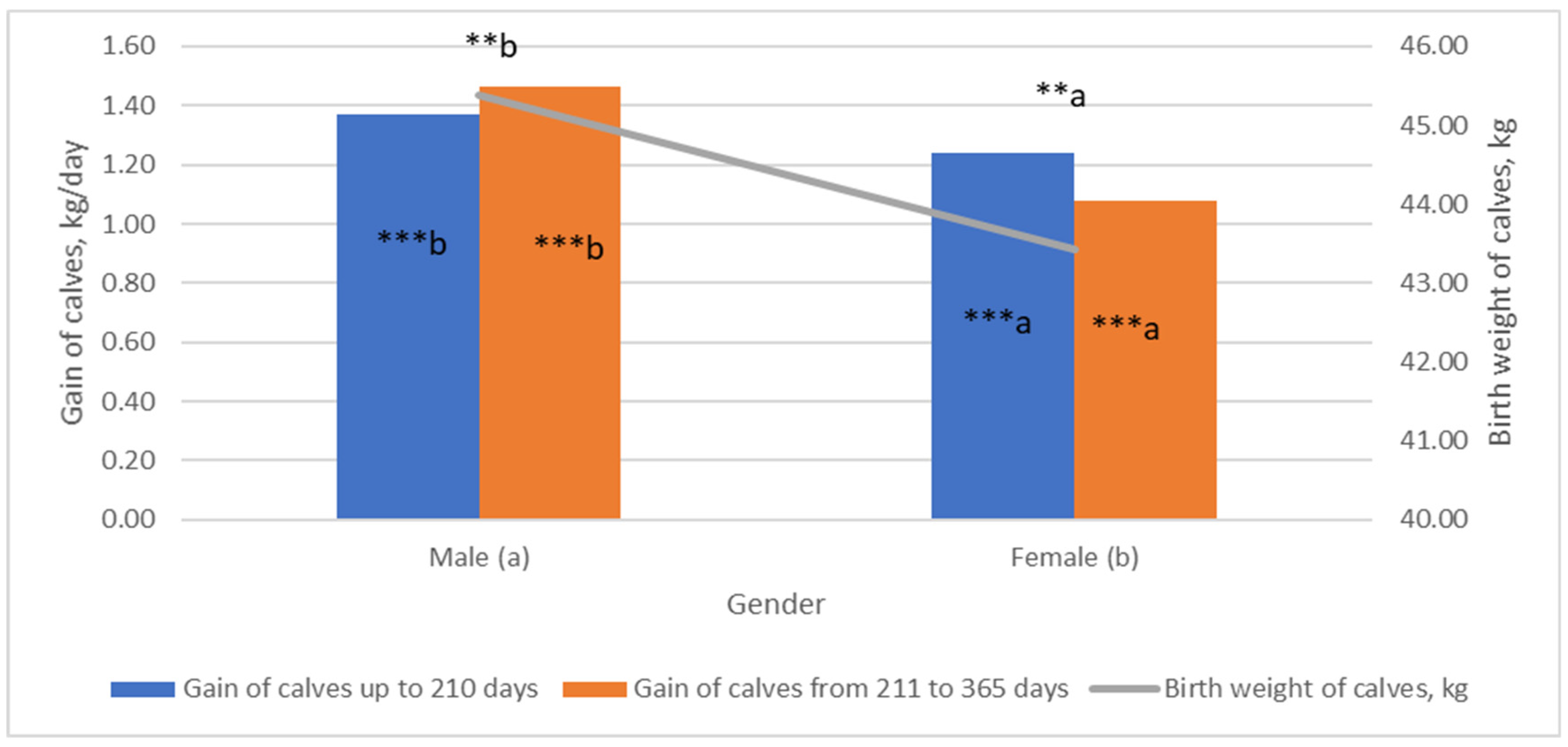
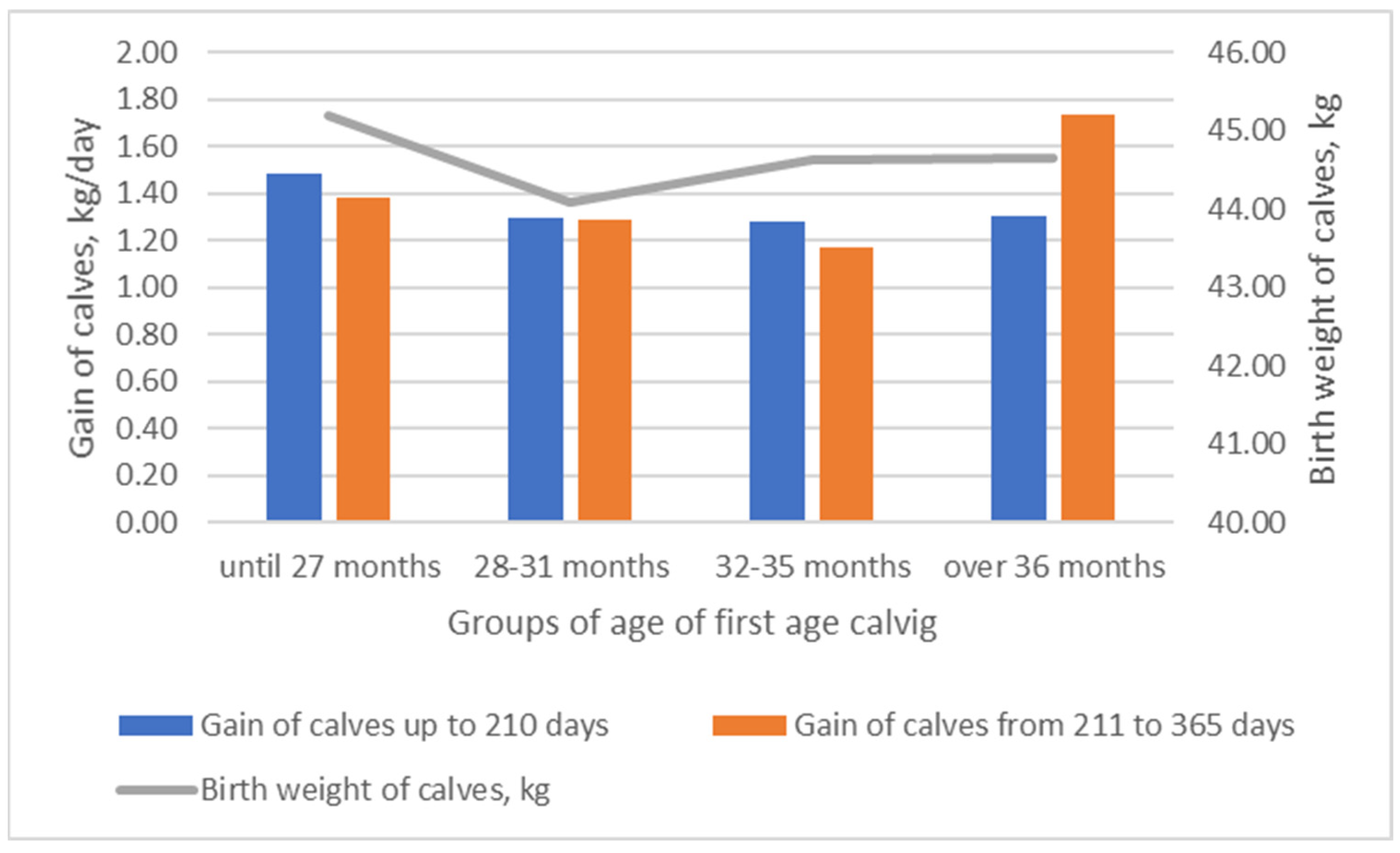
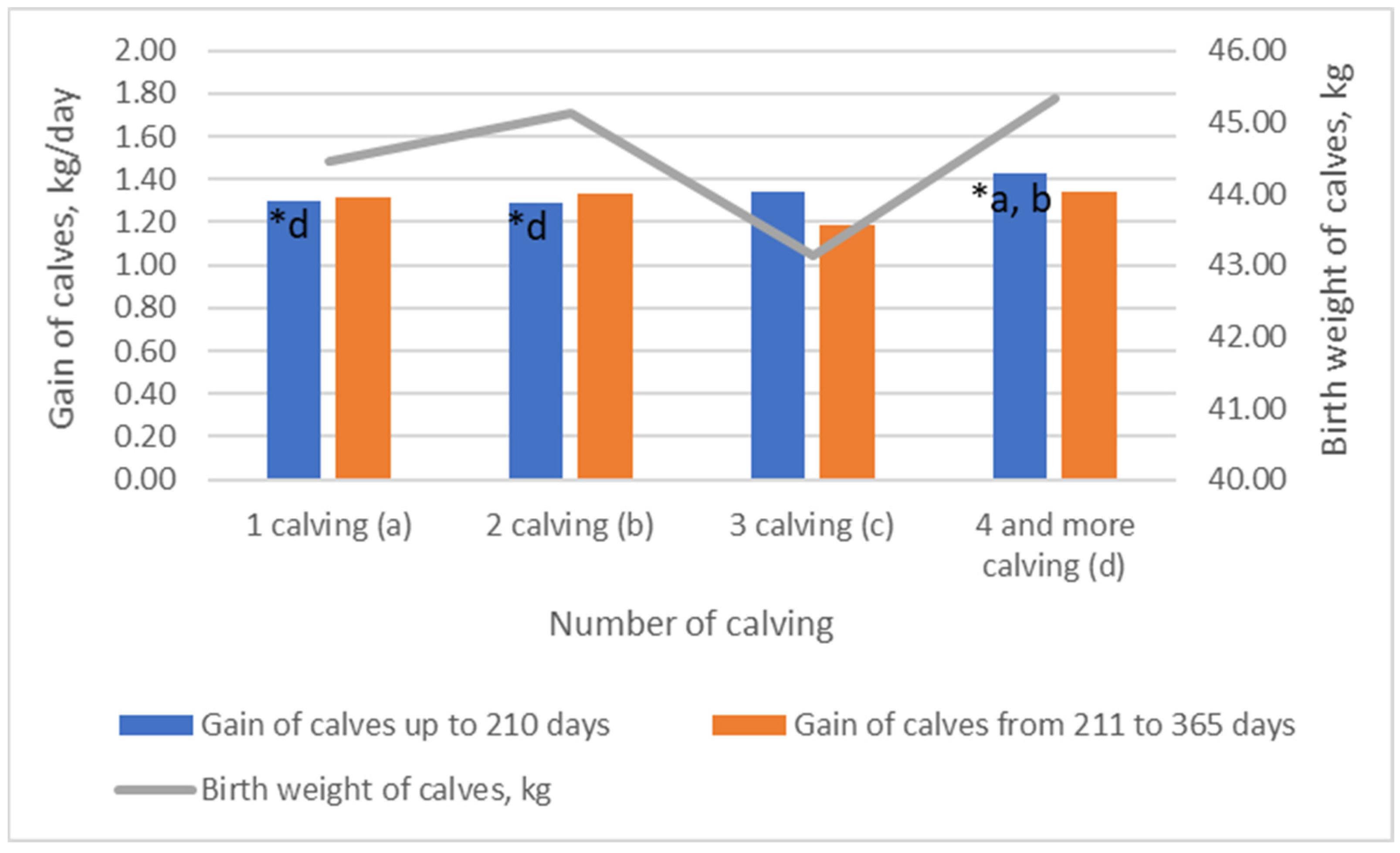
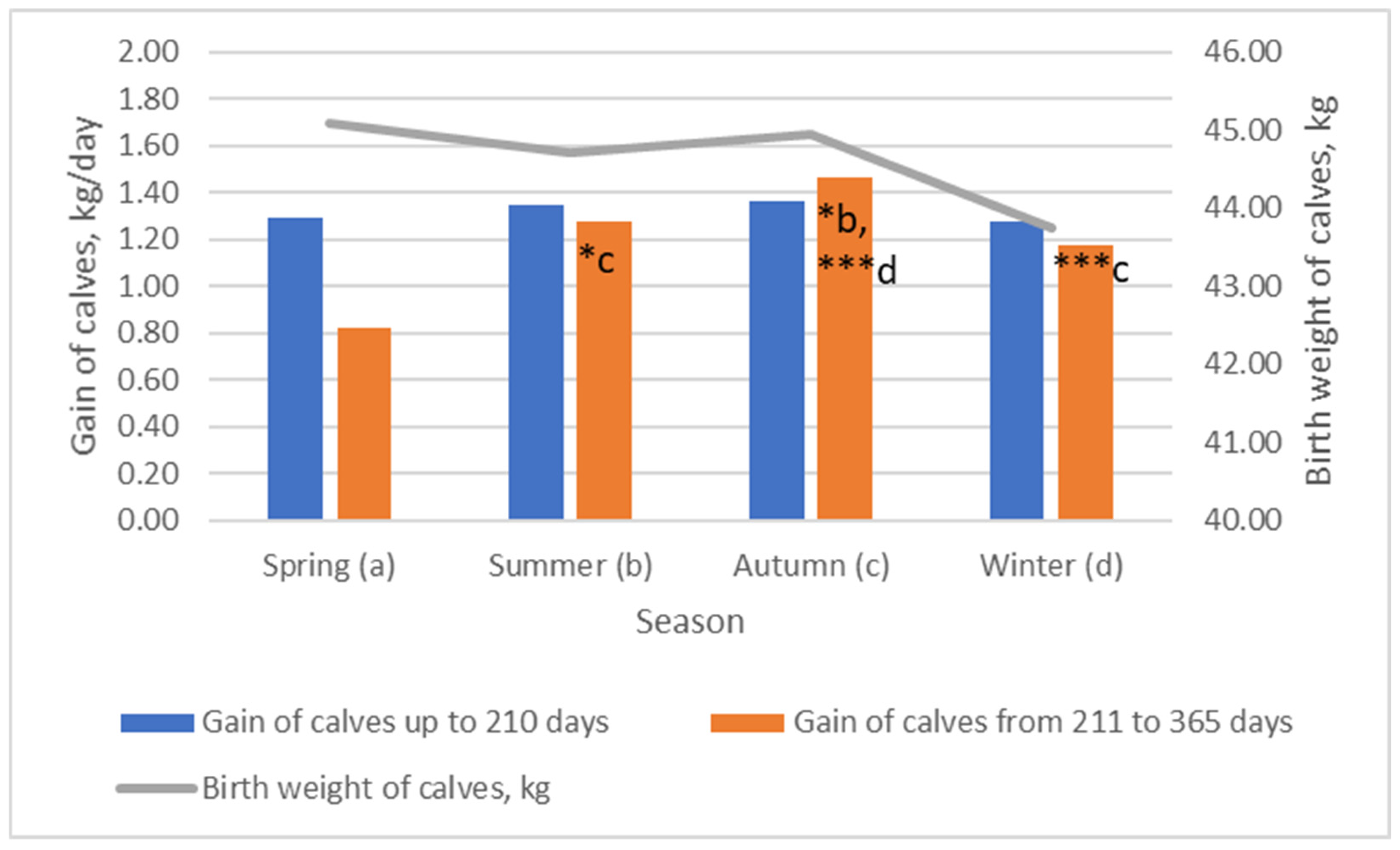
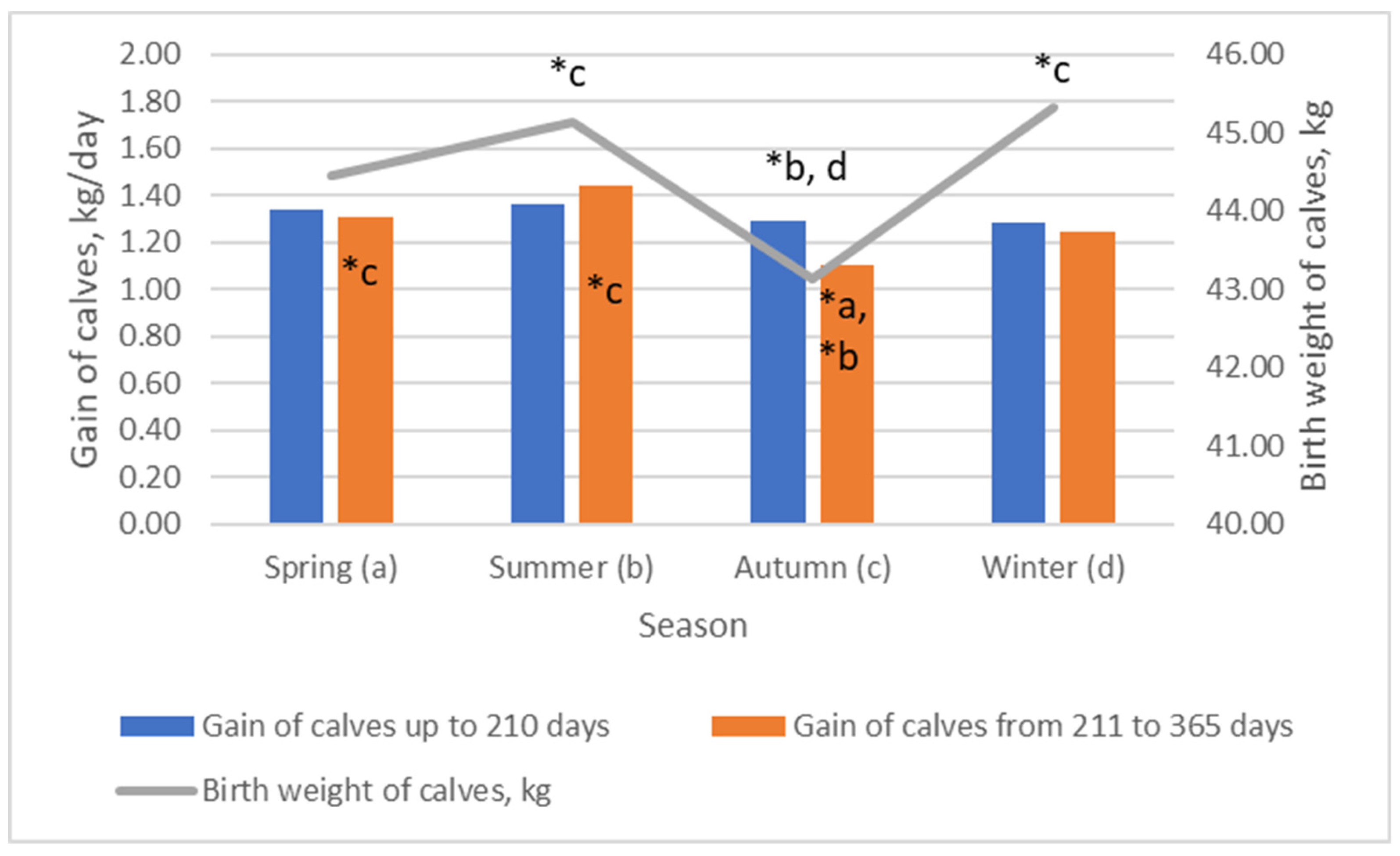
| Indicators | Pasteur Grass | Hay | Corn Silage |
|---|---|---|---|
| Dry matter, g/kg | 261 | 841 | 331 |
| Ash, g/kg | 84 | 59 | 48 |
| Crude protein, g/kg | 118 | 106 | 85 |
| Crude fiber, g/kg | 247 | 252 | 188 |
| Crude fat, g/kg | 33 | 22 | 28 |
| Total sugar, g/kg | 107 | 134 | 297 |
| Acid detergent fiber (ADF), g/kg | 297 | 366 | 204 |
| Acid detergent lignin, g/kg | 43 | 417 | 218 |
| Neutral detergent fiber (NDF), g/kg | 449 | 493 | 365 |
| Net energy for lactation (NEL), MJ | 6.31 | 8.49 | 6.60 |
| Fermentation rate | - | - | 28.65 |
| Indicators | Value |
|---|---|
| NE, MJ/kg | 11.00 |
| Crude protein, % | 18.10 |
| Lysine, % | 0.90 |
| Crude fiber, % | 3.50 |
| Crude fat, % | 2.50 |
| Green ash, % | 5.00 |
| Calcium (Ca) | 1.04 |
| Phosphorus (P) | 0.70 |
| Sodium (Well) | 0.21 |
| Magnesium (Mg) | 0.33 |
| Zinc, mg/kg | 105.00 |
| Manganese, g/kg | 95.00 |
| Copper, g/kg | 25.00 |
| Cobalt, g/kg | 1.10 |
| Iodine, g/kg | 2.00 |
| Selenium, g/kg | 0.30 |
| Indicators | The Homemade Forage |
|---|---|
| Dry matter, g/kg | 891 |
| Crude ash, g/kg SM | 120 |
| Crude protein, g/kg SM | 186 |
| Crude fiber, g/kg | 50 |
| Crude fat, g/kg | 18 |
| Total sugar, g/kg | 414 |
| Net energy for lactation (NEL), MJ | 7.35 |
| Calcium, g/kg SM | 18.89 |
| Phosphorus, g/kg SM | 6.83 |
| Magnesium, g/kg SM | 5.75 |
| Sodium, g/kg SM | 12.27 |
| Potassium, g/kg SM | 6.20 |
| Chlorine, g/kg SM | 1.32 |
| Sulfur, g/kg SM | 4.15 |
Disclaimer/Publisher’s Note: The statements, opinions and data contained in all publications are solely those of the individual author(s) and contributor(s) and not of MDPI and/or the editor(s). MDPI and/or the editor(s) disclaim responsibility for any injury to people or property resulting from any ideas, methods, instructions or products referred to in the content. |
© 2023 by the authors. Licensee MDPI, Basel, Switzerland. This article is an open access article distributed under the terms and conditions of the Creative Commons Attribution (CC BY) license (https://creativecommons.org/licenses/by/4.0/).
Share and Cite
Šlyžienė, B.; Mečionytė, I.; Žilaitis, V.; Butkienė, E.; Anskienė, L.; Šlyžius, E.; Palubinskas, G. The Association between Charolais Cows’ Age at First Calving, Parity, Breeding Seasonality, and Calf Growing Performance. Animals 2023, 13, 2901. https://doi.org/10.3390/ani13182901
Šlyžienė B, Mečionytė I, Žilaitis V, Butkienė E, Anskienė L, Šlyžius E, Palubinskas G. The Association between Charolais Cows’ Age at First Calving, Parity, Breeding Seasonality, and Calf Growing Performance. Animals. 2023; 13(18):2901. https://doi.org/10.3390/ani13182901
Chicago/Turabian StyleŠlyžienė, Birutė, Indrė Mečionytė, Vytuolis Žilaitis, Eglė Butkienė, Lina Anskienė, Evaldas Šlyžius, and Giedrius Palubinskas. 2023. "The Association between Charolais Cows’ Age at First Calving, Parity, Breeding Seasonality, and Calf Growing Performance" Animals 13, no. 18: 2901. https://doi.org/10.3390/ani13182901
APA StyleŠlyžienė, B., Mečionytė, I., Žilaitis, V., Butkienė, E., Anskienė, L., Šlyžius, E., & Palubinskas, G. (2023). The Association between Charolais Cows’ Age at First Calving, Parity, Breeding Seasonality, and Calf Growing Performance. Animals, 13(18), 2901. https://doi.org/10.3390/ani13182901






